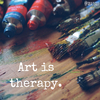Expanding Horizons: Role Playing Games and the Art of Storytelling
Welcome to Thalo’s “Expanding Horizons”! In this article series, we will be exploring and discussing topics relevant to artists that are either cutting edge, underground or under-reported in the creative world. Hopefully, these entries will help inspire you to explore new facets of your work and find new ways to make art work for you!
Expanding Horizons: RPG’s and the Art of storytelling
Role-Playing Games like Dungeons and Dragons have seen a massive resurgence over the last few years. The classic paper-and-pencil adventuring game genre has grown into a full-blown phenomenon, with entire conventions and content channels dedicated to the activity. Gameplay, cultlure and storytelling have taken front and center of this movement, with friends being the driving connection to the experience. Legions of fans dedicated to the craft of community storytelling have swelled and skyrocketed thanks to internet services like Youtube and Twitch TV that broadcast home games around the world.
There are many reasons why Role-Playing Games have become so popular. From pop-culture references in television and movies to online campaigns, there is something drawn from this activity that most artists and creatives often lack when creating: Community.
A brief introduction to Role-Playing Games
For the uninitiated, a role-playing game consists of many “Player Characters” and a “Game Master” (A storyteller, or a Card Dealer for a similar concept). The Game Master tells a story with the other players acting as the primary characters. Each character has unique attributes and abilities they can use to help in understanding the story. To determine the success or failures of what occurs in the game, you roll dice and allow the laws of calculated chance (and luck) to guide how the story progresses. You can play pre-arranged story modules or create your very own tale for people to play. Through this loose description,
Arguably one of the most famous Role Playing Game is Dungeons and Dragons, created by Gary Gygax in the ’70s. D&D is referenced heavily in popular culture, and the game’s publisher Wizard’s of The Coast has a large team of writers, artists, and designers that create new stories for people to play in. There are several other kinds of game systems that have different storytelling styles, including White Wolf, Deadlands, and many more.
Over the years, streaming services like Twitch and Youtube, as well as an entire generation of people who grew up playing RPG’s have created a vast community who play. These same people use the game to practice their world-building and storytelling skills to create unique experiences with their friends. Many creatives who write movies and designs for entertainment have some connection to Dungeons and Dragons, with notable celebrities like Joe Manganiello, Stephen Colbert, and Vin Diesel discussing their past enjoyment of the activity. It appears that many people have gotten their creative start with Role-Playing Games. But, how can an artist draw inspiration or gain from this kind of medium?
Using Art for fun
One of the biggest draws of RPG’s is its use of the imagination of the players at the table to help create the story and world. Because of this, people who can draw can help sharpen not only their drawing skills but their storytelling abilities. When a fun moment occurs in the game, it’s a great exercise to illustrate that moment for people to see.
There is also a vibrant community of artists that draw other people’s DnD characters and games. Some artists travel to conventions and will live draw games as they occur, adding a visual element to the game that not only elevates the game but catalogs it.
Creative Storytelling
The game is not relegated to any one person, age, or walk of life. Anyone can bring whatever experiences they want to the table to create a community-based experience for their friends. Because of this, given the fantasy settings of the game, it allows for an unlimited amount of possibilities for people to both hone their creative problem-solving skills, empathy, and improvisation in a safe and fun environment. Given the implementation of different ways to play the game, it allows for a myriad of experiences, whether it be exploring a new world or battling monsters (or both!). The framework allows for any kind of story to be explored, from romance, action, political intrigue, and more.
Artists are challenged to be creative and flesh out ideas, and Role Playing Games have an opportunity to do that in a group setting. Practicing and playing in an agreed-upon setting can help writing skills such as fleshing out a character, alternative thinking through acting, and creative exploration of different points of view through play.
Like most creative disciplines, RPG’s offer the addictive hook of rewarding you for what you put in. If you have a unique, original idea and a creative group of friends, you will have an exciting and fun experience.
Many artists turn to Role-Playing Games for inspiration, as the human element of creativity and interaction is there to help broaden your scope beyond whatever is in your head (something that many artists have difficulty with).
Accessibility
As mentioned earlier, thanks to the internet, anyone can watch a game, learn to play, or contribute to communities by producing artwork, creating concepts, or merely participating in gameplay. Online RPG Sites like Roll20 allow for people to connect with other players around the world and create games they would not be able to organize otherwise.
There are games, hobbies, and department stores (both online and off) that have some iteration of RPG, and if not, you can source and create your own games! So if you don’t have the resources to invest, you can simply create your own using your art supplies.
We hope this helps illustrate why RPG’s have become so popular and how artists can use this as a way to hone their craft and even network!







